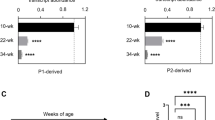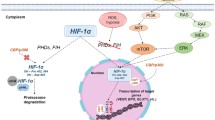Abstract
Caloric restriction remains the most reproducible measure known to extend life span or diminish age-associated changes. Previously, we have described an elevated expression of the prolyl-4-hydroxylase domain (PHD) 3 with increasing age in mouse and human heart. PHDs modulate the cellular response towards hypoxia by regulating the stability of the α-subunit of the transcriptional activator hypoxia inducible factor (HIF). In the present study we demonstrate that elevated PHD3, but not PHD1 or PHD2, expression is not restricted to the heart but does also occur in rat skeletal muscle and liver. Elevated expression of PHD3 is counteracted by a decrease in caloric intake (40% caloric restriction applied for 6 months) in all three tissues. Age-associated changes in PHD3 expression inversely correlated with the expression of the HIF-target gene macrophage migration inhibitory factor (MIF), which has been previously described to be involved in cellular HIF-mediated anti-ageing effects. These data give insight into the molecular consequences of caloric restriction, which influences hypoxia-mediated gene expression via PHD3.





Similar content being viewed by others
Abbreviations
- ARNT:
-
Aryl hydrocarbon receptor
- HIF-1:
-
Hypoxia-inducible factor-1
- MIF:
-
Macrophage migration inhibitory factor
- PHD:
-
Prolyl-4-hydroxylase domain
References
Abete P, Cioppa A, Calabrese C, Pascucci I, Cacciatore F, Napoli C, Carnovale V, Ferrara N, Rengo F (1999) Ischemic threshold and myocardial stunning in the aging heart. Exp Gerontol 34:875–884
Ahmet I, Wan R, Mattson MP, Lakatta EG, Talan M (2005) Cardioprotection by intermittent fasting in rats. Circulation 112:3115–3121
Appelhoff RJ, Tian YM, Raval RR, Turley H, Harris AL, Pugh CW, Ratcliffe PJ, Gleadle JM (2004) Differential function of the prolyl hydroxylases PHD1, PHD2, and PHD3 in the regulation of hypoxia-inducible factor. J Biol Chem 279:38458–38465
Bosch-Marce M, Okuyama H, Wesley JB, Sarkar K, Kimura H, Liu YV, Zhang H, Strazza M, Rey S, Savino L et al (2007) Effects of Aging and Hypoxia-Inducible Factor-1 Activity on Angiogenic Cell Mobilization and Recovery of Perfusion Following Limb Ischemia. Circ Res 101:1310–1318
Bruick RK, McKnight SL (2001) A conserved family of prolyl-4-hydroxylases that modify HIF. Science 294:1337–1340
Chang EI, Loh SA, Ceradini DJ, Chang EI, Lin SE, Bastidas N, Aarabi S, Chan DA, Freedman ML, Giaccia AJ, Gurtner GC (2007) Age decreases endothelial progenitor cell recruitment through decreases in hypoxia-inducible factor 1α stabilization during ischemia. Circulation 116:2818–2829
Coppe JP, Kauser K, Campisi J, Beausejour CM (2006) Secretion of vascular endothelial growth factor by primary human fibroblasts at senescence. J Biol Chem 281:29568–29574
Di Giulio C, Bianchi G, Cacchio M, Artese L, Rapino C, Macri MA, Di Ilio C (2005) Oxygen and life span: chronic hypoxia as a model for studying HIF-1α, VEGF and NOS during aging. Respir Physiol Neurobiol 147:31–38
Dozmorov I, Galecki A, Chang Y, Krzesicki R, Vergara M, Miller RA (2002) Gene expression profile of long-lived snell dwarf mice. J Gerontol A Biol Sci Med Sci 57:B99–B108
Epstein AC, Gleadle JM, McNeill LA, Hewitson KS, O’Rourke J, Mole DR, Mukherji M, Metzen E, Wilson MI, Dhanda A, et al (2001) C. elegans EGL-9 and Mammalian Homologs Define a Family of Dioxygenases that Regulate HIF by Prolyl Hydroxylation. Cell 107:43–54
Facchetti F, Monzani E, Cavallini G, Bergamini E, La Porta CA (2007) Effect of a caloric restriction regimen on the angiogenic capacity of aorta and on the expression of endothelin-1 during ageing. Exp Gerontol 42:662–667
Frenkel-Denkberg G, Gershon D, Levy AP (1999) The function of hypoxia-inducible factor 1 (HIF-1) is impaired in senescent mice. FEBS Lett 462:341–344
Higami Y, Barger JL, Page GP, Allison DB, Smith SR, Prolla TA, Weindruch R (2006) Energy restriction lowers the expression of genes linked to inflammation, the cytoskeleton, the extracellular matrix, and angiogenesis in mouse adipose tissue. J Nutr 136:343–352
Hwang IS, Fung ML, Liong EC, Tipoe GL, Tang F (2007) Age-related changes in adrenomedullin expression and hypoxia-inducible factor-1 activity in the rat lung and their responses to hypoxia. J Gerontol A Biol Sci Med Sci 62:41–49
Ivan M, Kondo K, Yang H, Kim W, Valiando J, Ohh M, Salic A, Asara JM, Lane WS, Kaelin Jr WG (2001) HIFα targeted for VHL-mediated destruction by proline hydroxylation: implications for O2 sensing. Science 292:464–468
Jaakkola P, Mole DR, Tian YM, Wilson MI, Gielbert J, Gaskell SJ, von Kriegsheim A, Hebestreit HF, Mukherji M, Schofield CJ et al (2001) Targeting of HIF-α to the von Hippel-Lindau ubiquitylation complex by O2-regulated prolyl hydroxylation. Science 292:468–472
Kang MJ, Kim HJ, Kim HK, Lee JY, Kim DH, Jung KJ, Kim KW, Baik HS, Yoo MA, Yu BP, Chung HY (2005) The effect of age and calorie restriction on HIF-1-responsive genes in aged liver. Biogerontology 6:27–37
Kato H, Inoue T, Asanoma K, Nishimura C, Matsuda T. Wake N (2006) Induction of human endometrial cancer cell senescence through modulation of HIF-1α activity by EGLN1. Int J Cancer 118:1144–1153
Katschinski DM (2006) Is there a molecular connection between hypoxia and aging?. Exp Gerontol 41:482–484
Koubova J, Guarente L (2003) How does calorie restriction work? Genes Dev 17:313–321
Mariani J, Ou R, Bailey M, Rowland M, Nagley P, Rosenfeldt F, Pepe S (2000) Tolerance to ischemia and hypoxia is reduced in aged human myocardium. J Thorac Cardiovasc Surg 120:660–667
Marxsen JH, Stengel P, Doege K, Heikkinen P, Jokilehto T, Wagner T, Jelkmann W, Jaakkola P, Metzen E (2004) Hypoxia-inducible factor-1 (HIF-1) promotes its degradation by induction of HIF-alpha-prolyl-4-hydroxylases. Biochem J 381:761–767
Masoro EJ (2000) Caloric restriction and aging: an update. Exp Gerontol 35:299–305
Maxwell PH, Wiesener MS, Chang GW, Clifford SC, Vaux EC, Cockman ME, Wykoff CC, Pugh CW, Maher ER, Ratcliffe PJ (1999) The tumour suppressor protein VHL targets hypoxia-inducible factors for oxygen-dependent proteolysis. Nature 399:271–275
Miller RA, Buehner G, Chang Y, Harper JM, Sigler R, Smith-Wheelock M (2005) Methionine-deficient diet extends mouse lifespan, slows immune and lens aging, alters glucose, T4, IGF-I and insulin levels, and increases hepatocyte MIF levels and stress resistance. Aging Cell 4:119–125
Miller RA, Chang Y, Galecki AT, Al-Regaiey K, Kopchick JJ, Bartke A (2002). Gene expression patterns in calorically restricted mice: partial overlap with long-lived mutant mice. Mol Endocrinol 16: 2657–2666
Paolucci S, Antonucci G, Troisi E, Bragoni M, Coiro P, De Angelis D, Pratesi L, Venturiero V, Grasso MG (2003) Aging and stroke rehabilitation. a case-comparison study. Cerebrovasc Dis 15:98–105
Rivard A, Berthou-Soulie L, Principe N, Kearney M, Curry C, Branellec D, Semenza GL, Isner JM (2000) Age-dependent defect in vascular endothelial growth factor expression is associated with reduced hypoxia-inducible factor 1 activity. J Biol Chem 275:29643–29647
Rohrbach S, Aurich AC, Li L, Niemann B (2007) Age-associated loss in adiponectin-activation by caloric restriction: Lack of compensation by enhanced inducibility of adiponectin paralogs CTRP2 and CTRP7. Mol Cell Endocrinol 277:26–34
Rohrbach S, Gruenler S, Teschner M, Holtz J (2006a) The thioredoxin system in aging muscle: key role of mitochondrial thioredoxin reductase in the protective effects of caloric restriction? Am J Physiol Regul Integr Comp Physiol 291:R927–R935
Rohrbach S, Niemann B, Abushouk AM, Holtz J (2006b) Caloric restriction and mitochondrial function in the ageing myocardium. Exp Gerontol 41:525–531
Rohrbach S, Simm A, Pregla R, Franke C, Katschinski DM (2005) Age-dependent increase of prolyl-4-hydroxylase domain (PHD) 3 expression in human and mouse heart. Biogerontology 6:165–171
Speakman JR, Hambly C (2007) Starving for life: what animal studies can and cannot tell us about the use of caloric restriction to prolong human lifespan. J Nutr 137:1078–1086
Welford SM, Bedogni B, Gradin K, Poellinger L, Broome Powell M, Giaccia AJ (2006) HIF-1α delays premature senescence through the activation of MIF. Genes Dev 20:3366–3371
Wenger RH, Stiehl DP, Camenisch G (2005) Integration of oxygen signaling at the consensus HRE. Sci STKE 306:re12
Acknowledgments
This work was supported by grants to D.M.K. (DFG Ka 1269/8–1) and S.R (DFG RO 2328/2–1; Deutsche Stiftung für Herzforschung F/05/05). We appreciate the technical assistance of B. Heinze.
Open Access
This article is distributed under the terms of the Creative Commons Attribution Noncommercial License which permits any noncommercial use, distribution, and reproduction in any medium, provided the original author(s) and source are credited.
Author information
Authors and Affiliations
Corresponding author
Rights and permissions
About this article
Cite this article
Rohrbach, S., Teichert, S., Niemann, B. et al. Caloric restriction counteracts age-dependent changes in prolyl-4-hydroxylase domain (PHD) 3 expression. Biogerontology 9, 169–176 (2008). https://doi.org/10.1007/s10522-008-9126-x
Received:
Accepted:
Published:
Issue Date:
DOI: https://doi.org/10.1007/s10522-008-9126-x




